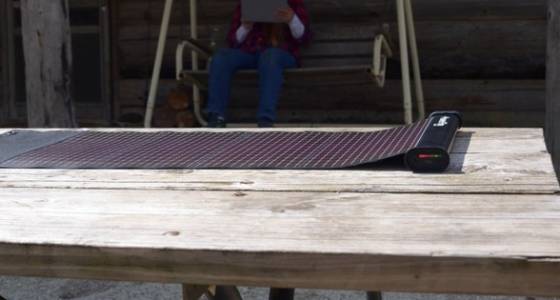These ultra-thin solar charging devices use amorphous silicon technology, which is said to be effective even in shady or lower-light conditions.
The next generation of solar chargers is going beyond lightweight and foldable, into full-on rollable solar panels, such as these ones from PowerFilm Solar, which can be rolled around their integrated battery bank for easy transport and storage.
© PowerFilm Solar
The company's LightSaver USB charger weighs under 5 ounces, rolls up into a tube measuring 1.5 inches in diameter and 7.8 inches long, and integrates a 3200 mAh lithium ion battery. That makes it one of the most compact solar chargers out there, as it takes up about as much space as a water bottle, even with its built-in battery bank. For charging, the LightSaver unrolls to about 18.5" long, and the battery can be fully charged with about 6 hours of exposure to sunlight (or about 3 hours via the micro-USB charging port). The LightSaver is designed to charge its battery bank with the solar panel, and a single 5V 1A USB port on the battery is then used for charging mobile devices. The cost for this device is about $99.
Last summer, PowerFilm Solar ran a successful crowdfunding campaign to launch a bigger solar charger, the LightSaver Max, which integrates a much larger capacity lithium ion battery (15,600 mAh) and a larger solar panel, but the charge time is about the same for this product as well (about 6 hours). The Max, which only weighs 1.5 lb, rolls up around the battery bank into a roll measuring 13.5" long by 2.5" by 1.5", and then deploys a 34.5" long fabric flap containing the 25.5" solar panel when in use. The battery has two 2.5A USB charging ports and a 5A 12V out port, as well as an integrated 660 lumen flashlight, and also includes USB-C and 12V input ports for charging from the grid. The Max is still available through the Indiegogo campaign for $275 (full MSRP is said to be $300).
© PowerFilm Solar
The advantages of the PowerFilm Solar chargers over conventional mono- or polycrystalline silicon panels are several, most notably the thin and lightweight nature of the chargers, but also the durability of the amorphous silicon panels (damage to one area of the panel will not keep the rest of the unit from performing), the relatively high performance of the panels in cloudy, shady, or lower-light conditions, and the incredibly flexible nature of the panels.
Here's a quick look at an "extreme durability" test of the company's thin-film solar panels:
The ability to roll the panels around the battery banks for storage or transport, coupled with their light weight, could make these solar chargers a good choice for those looking for a very compact and resilient product. The company also has a number of other thin-film products available as well, which can be seen on its website.
Our editors found this article on this site using Google and regenerated it for our readers.












